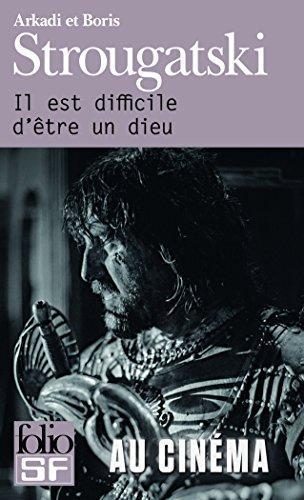The brothers Arkady Strugatsky (28 August 1925 – 12 October 1991) and Boris Strugatsky (14 April 1933 – 19 November 2012) were Soviet and Russian science-fiction authors who collaborated through most of their careers. In the second half of the 1950s, military translator A. N. Strugatsky, with the assistance of journalist L. S. Petrov and writer and intelligence officer R. N. Kim, published the documentary novella Ashes of Bikini (journal versions in 1956 and 1957, book edition in 1958) and secured a position as an editor at Goslitizdat. B. N. Strugatsky, who worked at the Pulkovo Observatory, also harbored literary ambitions; according to legend, the brothers decided to write together on a bet. Between 1957 and 1959, Arkady and Boris Strugatsky wrote the novella The Land of Crimson Clouds and several short stories, which immediately attracted the attention of critics. In 1964, the Strugatskys were admitted to the Union of Writers of the RSFSR. After years of experimentation, they developed a working method that involved not only joint discussion of ideas but also the oral rehearsal of every sentence. The writing process followed a detailed plan, which was developed in advance and discussed multiple times. Starting with works in the …
Arkady and Boris Strugatsky
The brothers Arkady Strugatsky (28 August 1925 – 12 October 1991) and Boris Strugatsky (14 April 1933 – 19 November 2012) were Soviet and Russian science-fiction authors who collaborated through most of their careers. In the second half of the 1950s, military translator A. N. Strugatsky, with the assistance of journalist L. S. Petrov and writer and intelligence officer R. N. Kim, published the documentary novella Ashes of Bikini (journal versions in 1956 and 1957, book edition in 1958) and secured a position as an editor at Goslitizdat. B. N. Strugatsky, who worked at the Pulkovo Observatory, also harbored literary ambitions; according to legend, the brothers decided to write together on a bet. Between 1957 and 1959, Arkady and Boris Strugatsky wrote the novella The Land of Crimson Clouds and several short stories, which immediately attracted the attention of critics. In 1964, the Strugatskys were admitted to the Union of Writers of the RSFSR. After years of experimentation, they developed a working method that involved not only joint discussion of ideas but also the oral rehearsal of every sentence. The writing process followed a detailed plan, which was developed in advance and discussed multiple times. Starting with works in the synthetic genre of adventure and scientific-technical fiction, the Strugatskys quickly transitioned to social prognostics and modeling in the form of "realistic fiction," with ideological content wrapped in a gripping plot. Most of their books explore the establishment of contact with alien intelligence, the question of the permissibility and justification of intervention or non-intervention in the natural evolution of civilizations of any type, and the study of various forms of utopia and dystopia. Significant attention in their work was devoted to the problem of the ideologization and de-ideologization of society and the role of culture in the state. In the first half of the 1960s, the Strugatskys created a unified fictional universe, conventionally called the Noon Universe, which serves as the setting for nearly a dozen novellas. The image of communism they constructed evolved toward permanent geopolitical and cosmic expansion and associated mechanisms of social control. Their exploration of various forms of utopia led the Strugatskys (starting with The Far Rainbow) to the conviction that humanity would inevitably split into unequal strata, not all of whose members are suitable or worthy of entering a bright future. The prospect of creating a biological civilization that radically reconstructs human nature and opposes technical culture also concerned the co-authors. From the 1980s, B. N. Strugatsky began to reassess their joint creative path in the context of liberalism and dissidence. Having achieved significant fame in the 1960s, the Strugatskys faced persecution of philosophical fiction in the USSR by the Department of Agitation and Propaganda of the Central Committee of the CPSU and the leadership of the All-Union Leninist Communist Youth League. In the 1970s and the first half of the 1980s, the number of publications and reprints decreased, and several lengthy texts gained semi-banned status, circulating in samizdat (e.g., The Ugly Swans). Based on the novella Roadside Picnic, which had no book editions at the time, the Strugatskys wrote the screenplay for A. Tarkovsky's film Stalker (1979). In the 1980s, the Strugatskys became some of the most published Soviet writers, a symbol of independent thought, and were awarded the RSFSR State Prize named after M. Gorky (1986). Between 1991 and 1994, the publishing house Tekst released the first collected works of the Strugatskys. In the 1990s, numerous editions were published, including the series Worlds of the Strugatsky Brothers. A group of Strugatsky researchers (the so-called "Ludeny Group") published an 11-volume collected works based on archival texts between 2001 and 2003, and a complete 33-volume collected works between 2015 and 2022. The Strugatskys' work significantly influenced the spread of dissent among the Soviet intelligentsia in the 1970s and 1980s, and was studied by literary scholars, social philosophers, and political scientists due to its interest ideological and literary constructs.
